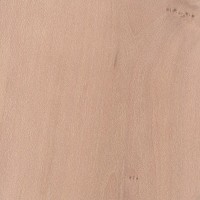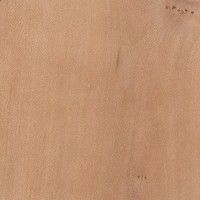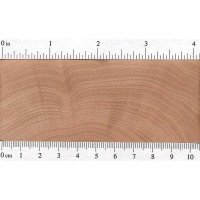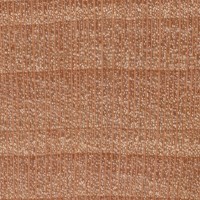 |
Common Name(s): Dogwood, Flowering Dogwood Scientific Name: Cornus florida Distribution: Eastern North America Tree Size: 30-40 ft (9-12 m) tall, 1-1.3 ft (.3-.4 m) trunk diameter Average Dried Weight: 51 lbs/ft3 (815 kg/m3) Specific Gravity (Basic, 12% MC): .64, .82 Janka Hardness: 2,150 lbf (9,560 N) Modulus of Rupture: 16,720 lbf/in2 (115.3 MPa) Elastic Modulus: 1,922,000 lbf/in2 (13.26 GPa) Crushing Strength: 8,740 lbf/in2 (60.3 MPa) Shrinkage: Radial: 7.1%, Tangential: 11.3%, Volumetric: 19.9%, T/R Ratio: 1.6 |
Color/Appearance: Most boards and blanks and composed primarily of sapwood rather than heartwood. Narrow heartwood is a reddish brown. Wide sapwood is cream to pale pinkish in color.
Grain/Texture: Grain is interlocked, with a fine, uniform texture. Moderate natural luster.
Endgrain: Diffuse-porous (growth rings generally distinct due to gradually decreasing pore density in latewood); small to medium pores in no specific arrangement, moderately numerous to numerous; exclusively solitary; tyloses occasionally present; parenchyma not visible; medium to wide rays, spacing normal.
Rot Resistance: Since there tends to be very little heartwood, Dogwood is usually composed entirely of sapwood, which is considered non-durable to perishable. Also susceptible to insect attack.
Workability: Despite it’s high density and interlocked grain, Dogwood tends to produce decent results with both hand and machine tools, though it can have a blunting effect on cutters. Glues, turns, and finishes well.
Odor: No characteristic odor.
Allergies/Toxicity: Besides the standard health risks associated with any type of wood dust, no further health reactions have been associated with Dogwood. See the articles Wood Allergies and Toxicity and Wood Dust Safety for more information.
Pricing/Availability: Not generally available commercially. Small quantities of Dogwood are occasionally harvested and utilized locally throughout its natural range, with prices high for a domestic hardwood.
Sustainability: This wood species is not listed in the CITES Appendices or on the IUCN Red List of Threatened Species.
Common Uses: Golf club heads, textile shuttles, bows (archery), mallets, pulleys, and turned objects.
Comments: Dogwood has excellent shock resistance, and is one of the hardest domestic woods of the United States or Canada. Its toughness is appreciated in a variety of applications, though its poor dimensional stability means that its use is usually restricted to unglued/unjoined standalone components where it’s expansion and contraction can occur freely.
None available.
None available.
Scans/Pictures: A special thanks to Mike Leigher for providing the wood sample of this wood species.








Does anyone know how other dogwood species stack up to Cornus Florida? Specifically species like Cornus Racemosa or Cornus Drummondii? There isn’t much info on them since they are smaller trees.
Does anyone know if Dogwood can be used to make stave drums? I’ve read elsewhere that dogwood isn’t stable enough for glue-based projects, but wouldn’t that merely be a function of properly drying it?
Dogwood makes great knife handles after stabilized. Very durable must be dried well before stabilized.
We have Cornus sanguinea and Cornus mas in Hungary. Both are great for hiking sticks, tool handles and also for the Hungarian martial art’s fencing sticks and for shepherd’s axe handle. It is also a very heavy wood, compared to hazelnut for example. I like that too, much lighter and fairly stiff too.
Do you think there is any around Sigliget? Or what is the range in Hungary? We hope to visit again next year. I just cut some peices from an old log that has been on the ground a lo g time. It has a lot of heartwood and the heart seems to be rot resistant as I find it it in the woods with the sapwood all gone.
I cannot really talk about ranges, as I saw it some parts, not at the other parts of the mountain range of the Mecsek (Souther Hungary, Western Mecsek is around Pécs city). Two very close “peaks”, parts of the Mecsek, Misina (where is the Pécs city TV-tower) has a plenty of them, but for example Jakab-hegy (“Mount Jacob”) has almost none of them, just a bit west from the Misina. I don’t understand it, maybe the soil is different? I was in Szigliget 30 years ago, exactly. I was kid back than, so I’m sorry, I have no idea about… Read more »
You can straighten the branches over fire. This is how my walking sticks were prepared. Look for videos by “Bucavasgyúró” on youtube, he presents the process. https://www.youtube.com/watch?v=r8BO8KecVH8
Ah, thank you! I know that guy – not personally unfortunately – he is a kind of blacksmith doing the ancient way of blacksmithing. He has nice pieces of work.
Can be sort of pinkish, but it loses this as it oxides in the sun, looking a bit like maple with a miniature medullary fleck on the quarter a la beechwood. Expect degrade on drying, warping, some cracking, but not too bad. Seal log ends well, 3 coats of glossy paint, or even wood glue works. The wax is more expensive and not as good, in my experience. Most important–remove ALL bark, including the tenaciously attached inner bark. Worms love dogwood, and their eggs will be in the bark. You will be rewarded with one of the hardest, strongest, stiffest,… Read more »
I have a very large Pacific dogwood in my yard that is dying. I hate to cut such a beautiful tree, but I have no choice as it is a hazard. It is about 18-20 inches in diameter at the base, with lots of burls. So while I do not want to cut it down, I will make use of it and have a friend saw it into lumber. I am looking forward to trying to make something out of it, maybe a live edge coffee table.
This guy Justin Davies is a tree historian on Instagram & TikTok he would be interested in a piece of your dogwood for a state tree map he is creating
https://www.instagram.com/tv/CZK7DPsPfEb/?utm_medium=copy_link
Same here. I have a massive Pacific dogwood (Washington State) as well and it’s near the end of its life. My arborist tells me you just don’t see big ones like this very much anymore. We’re going to remove a bunch of dead sections and see if we can extend its life a little longer. I know it’ll cost me more in the long run (more than just cutting the whole thing down), but I really like the tree. I’ve been thinking about buying an Alaskan mill to try on it, but more likely I’ll just make some small things… Read more »
In my experience with milling my own dogwood, it has a very distinctive odor
Some disease has affected the dogwood in my area and I’ve harvested a couple of trees. I found that they shrink and consequently, check a great deal as they dry. My goal was to quarter saw, dry and then make ukulele sides and backs out of the dried lumber. I’ve made three and they are both beautiful and functional. I waited 2 years to find the trees. SC Brad
Dogwood trees 2-3 inches in diameter, dig up, the root will have a great ready-made mallet.
I plan on making a Tennessee Soddy chunk gun and have found the log large enough to make the stock out of
I used a piece of quartersawn dogwood for a guitar fingerboard. and a bridge. It worked very well. I’d like to get some more, quartersawn dogwood, if it’s available.
My family is in the nursery business, specializing in grafted dogwoods (my grandfather has a variety of pink dogwood named after him). We generally sell them at a year to two after grafting, so not very big, certainly not big enough to serve as “lumber”. But many years ago, my grandfather transplanted a bunch of them on some land and just let them grow. That land is now mine, and the trees are tall and thick. So I have a source of dogwood lumber now. Question is, what can I do with it? My dad once speculated that dogwood would… Read more »
Where are you located? I’m sure there’s a nearby woodworking group that would be delighted to purchase some logs from you.
Dogwood make very nice mallets. smaller ones for chisels, large ones for driving a froe.
it makes good wedges for splitting wood. when shaping it with a hatchet., the tool will bounce as if cutting glass or metal…..its that hard.
Dogwood was used for spears in the ancient world – especially the famous Sarissa pikes that Alexander the Great (after his father, Philip) used to conquer the Persian Empire and into India.
If you still have any, and you can find a historical recreator, then it would be a fascinating project for them.
I’m actually a resident batsmith in my area (south florida) and I prefer higher density woods for my bats. If you make the barrel thinner, you GAIN sweet spot, because the area you’re making contact is reduced vertically, but greatly increased horizontally, which is more important. The difference in barrel diameter at most is .2 inches from either latitude, which doesn’t affect launch angle at all. The real problem with smaller barrels is that you make the bat more balanced, which doesn’t have as much energy behind the swing. You COULD make the overall bat simply heavier, but the loss… Read more »
Would you recommend this wood for fencing? How woukd it compare on durability vs pine and cedar?
No, I don’t think that dogwood would be a good fit to be used for fencing. It is usually almost all sapwood, which would not hold up to the weather very well at all.
My father found some dead standing dogwood at the ranch he works. The time standing dead gave it some gorgeous spalting character and yet its still incredibly dense and easy to turn. I have plenty of sticks of dogwood that are all about 5-7″ wide, if anyone is interested. The pic below is a sample of the spalting in the blocks.
I’m having trouble finding dogwood in my area, New Orleans. Any recommendations as to whom I could go through for a piece? I realistically only need a small piece for a project.
I have a bit of spalted dogwood that my father harvesting from standing dead trees in East Texas, if you are interested. Here is a pic of a mallet that shows the spalting.
That’s great. Do you have any pieces that are about 14 inches long? If so, could you quote me a price?
I work with dogwood quite a bit. Its tough and stubborn, but it shines
up beautifully. I recommended it. This bowl is about 8″ x 8″
Looks fabulous guy..
Hmm, interesting. It appears, from the pattern of the grain, that this piece was turned on an axis perpendicular to the grain. I’ve never used a lathe myself, so I may very well be wrong on this. But intuitively, it seems to me that not only does that result in less strength, but it would also be harder to cut. If I’m wrong about that, please, relieve me of my ignorance. Definitely a beautiful piece of work, though, either way.
I work with dogwood quite a bit. Its tough and stubborn, but it shines up beautifully. I recommended it. This bowl is about 8″ x 8″
I have worked with dogwood quite a bit and have found it to
have a somewhat spicy scent that fades quickly after cuting.
Most of the Dogwood I have encountered generally has a pinkish hue. I have some exceptionally large pieces, 4/4 thick, 5 to 6 inches wide, and 7 and 8 foot in length. The wood is fairly difficult to work with and tends to twist when it dries. It also tends to make fine to very fine dust when cutting even when cuts are made with the grain. IT also tends to split easily when using brads or other fasteners without pre-drilling. Sharp tooling is a must. It does finish nicely with clear lacquer, I do not normally stain woods so… Read more »
I like the strength. I have quite a few trees around property rather small. Only 6-8 inches trunk sizes mostly. Burns nice in the stove too. Seasons in a year.